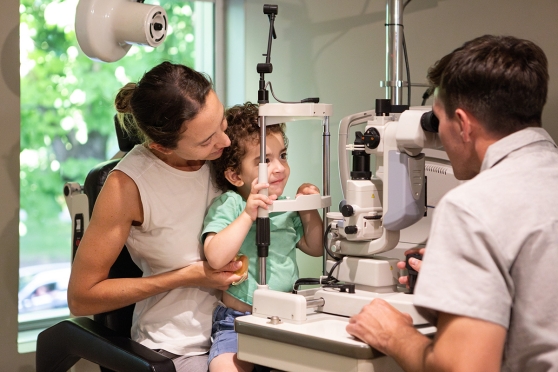How to know if a child needs glasses — and how to use vision benefits for a first pair
When children have vision problems, the signs aren’t always obvious. Here's how to spot them and what steps to take.

It’s not always easy to tell when a child has trouble seeing. Blurry vision or sore eyes might go unnoticed—or the child may not even know anything is wrong. That’s why spotting the signs of vision problems early really matters. The right pair of glasses can make a big difference and can make reading, learning and playing much easier and way more fun.
Here are 7 signs that something might be wrong with a child’s eyesight.
1. Squinting or covering one eye
One of the most common signs of a vision problem is squinting. This can happen when trying to see things far away, like the board in a classroom. Or squinting can occur when trying to see close-up, like when reading a book. While it can helps focus the eyes, squinting may also mean they are not working as they should.
Some children cover one eye to try to see better. This may mean one is stronger than the other or that both eyes aren’t working well together. An eye care provider can test each eye and help find the best way to correct the problem.
2. Holding books or devices too close
When a child holds a tablet or book very close to the face, it could be a sign of nearsightedness. This means far-away things look blurry while close-up items look clear.1 Watching for this habit can help catch vision problems early.
Reading too closely can also lead to tired eyes. Children may take longer to finish homework or lose interest in reading if it becomes too hard to see clearly.
3. Frequent headaches or rubbing the eyes
Headaches near the front of the head or around the eyes can come from eye strain.2 This often happens after reading, using a screen or doing schoolwork. The eyes may be working too hard to focus, especially if the child has an outdated or missing prescription.
Rubbing the eyes during the day may be another sign. It can mean the eyes feel tired or uncomfortable. If this happens often, it may be time for a vision check.
Already have a primary care doctor who knows you inside and out? Add an eye care provider to your care team to take care of your eyes. Search the UnitedHealthcare Vision Network now.
4. Sitting too close or tilting the head
Children with trouble seeing far away may sit very close to the TV or computer. This helps make the image larger and clearer. It may seem like a habit, but it could be a sign of nearsightedness.
Learn more about nearsightedness (or myopia) in children by downloading our free myopia guide.
Some children tilt or turn their head while reading, writing or watching something. This may mean the eyes are not working together.3 One eye may be stronger than the other. And turning the head can help the stronger eye to do more of the work. It can also be a way to reduce double vision or focus better.
5. Falling behind in school or losing focus
Vision problems can make learning harder. If a child can’t see the board clearly or has trouble reading small print, schoolwork may take longer. Mistakes may happen more often, especially during reading, writing or math.
Some children with vision issues may seem distracted in class. Teachers may notice them looking away, losing their place while reading or avoiding eye contact with the board. These behaviors can sometimes be mistaken for attention problems.
6. Avoiding visual activities
Many children enjoy games that involve looking closely, such as puzzles, coloring books or board games. But those with vision problems may avoid these activities. They may say the games are “boring” or “too hard,” but the real reason could be eye strain or blurry vision.
If a child suddenly loses interest in favorite visual tasks, it may be worth checking how well they can see. Difficulty seeing clearly can make once-fun games feel like a struggle.
Stay on top of your eye health with an in-network provider. Search for an eye care provider now.
7. Changes in mood or behavior
When vision problems go unnoticed, they can affect how a child feels day to day. Eye strain and headaches can cause:
- Tiredness
- Irritability
- Mood swings
In some cases, vision challenges may cause frustration, leading to behavior changes or a loss of confidence in school.4 Parents and teachers may not always connect these changes to vision. But when no other cause is clear, an eye exam can help rule out sight-related issues.
Sources
- Nearsightedness Mayo Clinic, April 19, 2024
- Eyestrain Mayo Clinic, July 2, 2024
- 11 Key Signs of Learning Difficulties From Vision Problems Optometrists Network
- Certain Classroom Behaviors May Be Related To Poor Vision National Center for Children’s Vision and Eye Health


